Did you know that some rare animals breathe through their skin? While it may seem like something out of a science fiction book, skin breathing, also known as cutaneous respiration, isn’t all that shocking in the animal world. Almost all animals absorb some trace amounts of oxygen through their skin!
However, a few animals almost completely rely on skin breathing for all or most of their oxygen. Keep reading below to meet them!
What Is Skin Breathing?
The scientific term for skin breathing is cutaneous respiration or cutaneous gas exchange. Cutaneous is a word that refers to the skin, while respiration is the biological process of creating necessary energy by taking oxygen and eliminating carbon dioxide in the body. In simple terms, respiration is just breathing!
Let’s think about respiration in humans. We take in a breath, our lungs inflate, and then we exhale. During this time, the blood becomes oxygenated, and it then travels around the body to deliver oxygen to our cells. As it becomes deoxygenated, it picks up waste, such as carbon dioxide, that is filtered out of the body.
However, this isn’t considered cutaneous respiration, as you’re using the lungs, not the skin. So, how exactly do animals breathe through their skin?
How Do Animals Breathe Through Their Skin?
Believe it or not, the process of cutaneous respiration isn’t all that different from the breathing we are used to with our lungs.
Whether it’s air or water, all of the fluid around us is filled with oxygen molecules. This means that there are always oxygen and other types of gas molecules touching our body at all times. While it seems solid, skin is permeable, allowing molecules and substances to enter or leave the skin.
As a result, with skin breathing, animals can absorb the oxygen around them into their skin. Here, through a process known as diffusion, the oxygen reaches the thin blood vessels near the skin’s surface, and then, like with lungs, the oxygenated blood is delivered around the body. It’s the same for carbon dioxide, which is eliminated from the body through the skin. This is where the name cutaneous gas exchange comes from.
Advantages of Skin Breathing
Skin breathing is one of the most primitive forms of respiration. It’s unable to provide large amounts of oxygen to the body, and it requires extremely specific conditions to work well. However, that isn’t to say it is without its advantages.
One of the main advantages of skin breathing is its versatility. Oxygen concentrations can vary depending on where you are. As a result, if you use lungs only, you’re limited to where you can breathe. However, when animals rely on skin breathing, they can intake oxygen from different places. As a result, animals that breathe through their skin can typically survive in or out of water well.
Disadvantages of Skin Breathing
As mentioned previously, the largest disadvantage of skin breathing is that it cannot support large organisms on its own. Skin breathing also requires completely smooth skin, with no fur or scales and a large amount of moisture.
9 Animals that Breathe Through Their Skin
All animals, including humans, utilize their skin for at least some oxygen absorption. However, because this makes up such a trace amount of oxygen, it isn’t often thought about when considering breathing.
As a result, here are nine animals that breathe through their skin (and rely on it for most or even all of their oxygen intake)!
1. Frogs and Toads
When it comes to skin breathing, frogs and toads are some of the most notable animals to utilize this form of respiration. In fact, if you’ve learned about this in school, your teacher most likely used frogs and toads as an example!
This is because frogs and toads are a great way to see the extent of skin breathing. These animals are amphibians, which means they thrive in damp locations, usually in water and on land. As a result, they require the ability to breathe no matter which type of environment they are in.
If you’ve ever held a frog or toad, you’ll also notice that they have smooth, scaleless skin. It’s also usually a little slimy, especially if you’re dealing with a frog and not a toad. This smooth, moist skin helps them absorb oxygen.
Frogs and toads both have lungs. However, their lungs only provide a small percentage of their total oxygen.
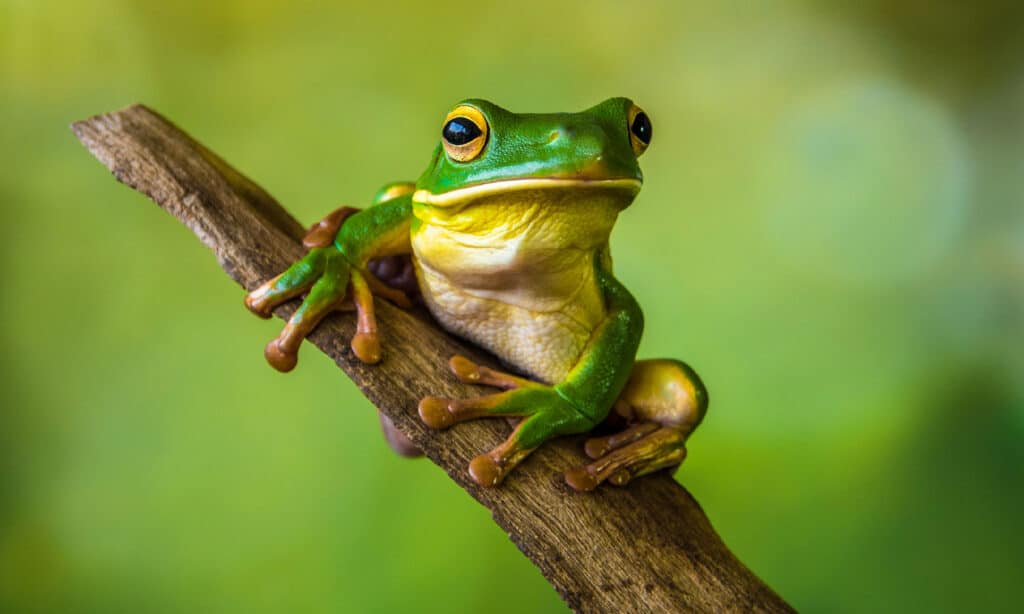
The moist skin of frogs and toads helps them absorb oxygen.
©iStock.com/LESSY SEBASTIAN
2. Lungless Salamander
As mentioned previously, skin breathing isn’t meant to sustain larger animals. This means that if you find an organism that relies heavily on skin breathing, it’s probably a primitive species or invertebrate, such as a sponge or coral. However, the same cannot be said for the lungless salamander.
The lungless salamander actually receives almost 100 percent of its needed oxygen through its skin. The name “lungless salamander” is given to a family of species, not just a single species. This would be the family Plethodontidae, which has nearly 400 different species of salamanders that depend on skin breathing to survive.
Salamanders in the family Plethodontidae are the only vertebrae to rely on skin breathing completely.
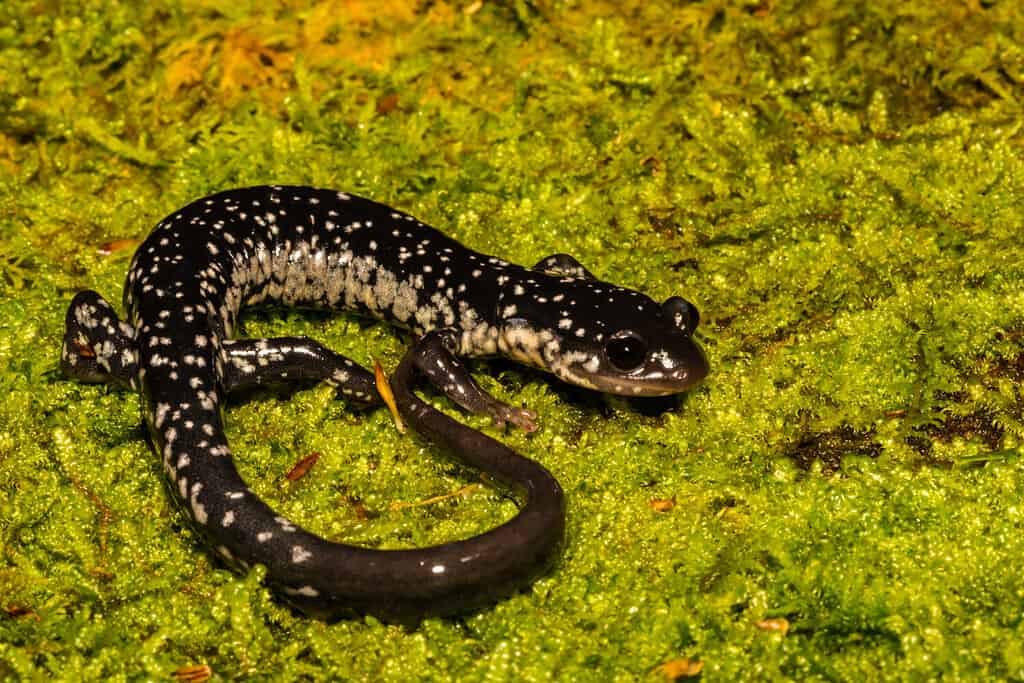
The name “lungless salamander” is actually given to the family
Plethodontidae.
©Jay Ondreicka/Shutterstock.com
3. Newts
Newts are a type of salamander. The name “newt” specifically refers to any salamanders in the Pleurodelinae subfamily.
Like many other animals that breathe through the skin, newts are semiaquatic. This means they live in water or land, much like frogs. More than 100 species of newt are known worldwide, with the potential for more to be discovered in the future!
Newts go through three different life stages, each alternating which environment they’re in. This is why skin breathing can be so beneficial for them. When a newt is first born, it goes through a stage where it is completely aquatic or living in the water. As they grow older, they emerge from the water in their juvenile stage, known as an eft. At this point, they’re completely terrestrial!
Once they finally reach adulthood, newts can thrive in both locations. They spend a large amount of time on land, but they’ll also return to the water to hunt occasionally as well as to breed.

Like frogs, newts are semiaquatic.
©Milan Zygmunt/Shutterstock.com
4. Earthworms
Although they may not be one of the first animals you think of, earthworms are great examples of animals that breathe through the skin! It can be difficult to breathe when you’re underground, and so skin breathing allows earthworms to tunnel under the earth without the fear of suffocation.
However, compared to the other animals on this list so far, you may notice something different about the earthworm. They don’t live in water! This is why you’ll usually only find earthworms in dark, damp soil. This includes under logs and in your vegetable garden!
Earthworms don’t have any lungs at all, so breathing through the skin is especially important for them to survive.
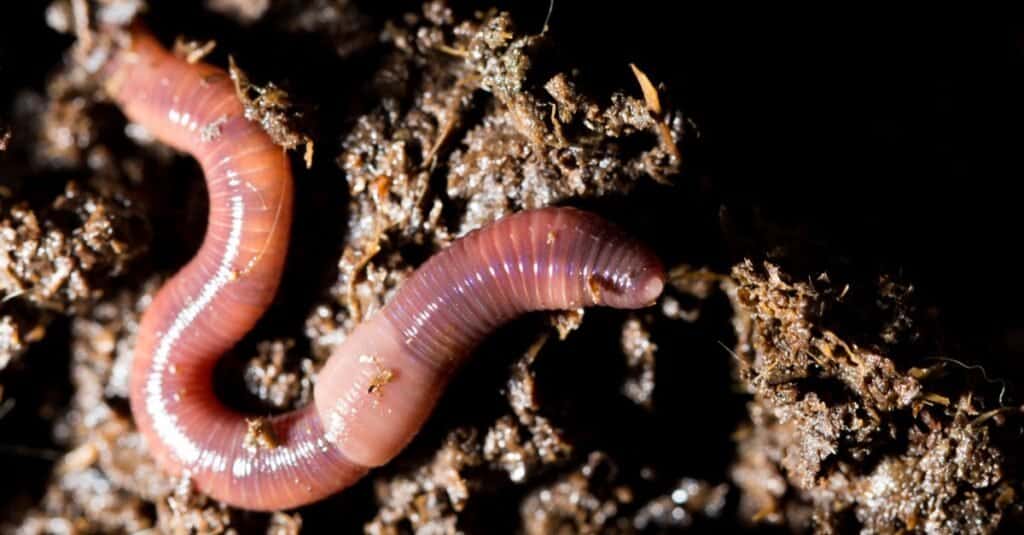
Earthworms breathe through the skin.
©schankz/Shutterstock.com
5. Caecilians
Caecilians are rare and interesting animals that not a lot of people have heard of. They can easily be mistaken for snakes, thanks to their appearance. Like many other animals that breathe through their skin, caecilians are actually amphibians. You can find them in warmer regions such as South America, Central America, Africa, and southern Asia. Here, they live in the damp earth of the forests and near streams. Their diet mainly consists of earthworms, another type of skin-breathing animal.
Their anatomy is completely designed to help them burrow and dig, just like with worms. They have long, slender, slimy bodies, as moisture is important for their health and ability to breathe.
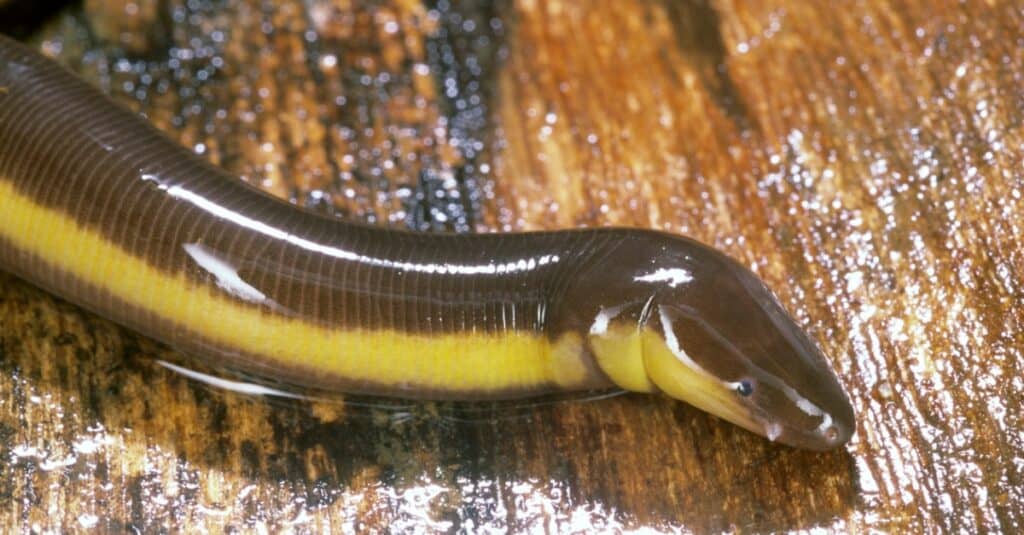
Earthworms constitute a major part of the caecilian diet.
©RealityImages/Shutterstock.com
6. Axolotls
Axolotls are one of the most popular amphibians to keep as a pet. However, they’re also one type of rare animal that breathe through their skin.
These little amphibians are actually a type of salamander. They’re closely related to the tiger salamander. Although they can be found in captivity almost everywhere in the world because of their popularity as a pet, they can only be found in one place in the wild: Lake Xochimilco. Previously, they could be found in Lake Chalco as well, but the lake no longer exists due to draining. With Lake Xochimilco facing a similar fate, wild axolotls are in danger of extinction.
Not only is the axolotl interesting in that it is capable of cutaneous gas exchange as a means of getting oxygen, but it also has other amazing abilities. This includes regeneration, allowing them to heal and regrow entire limbs, just like a starfish!
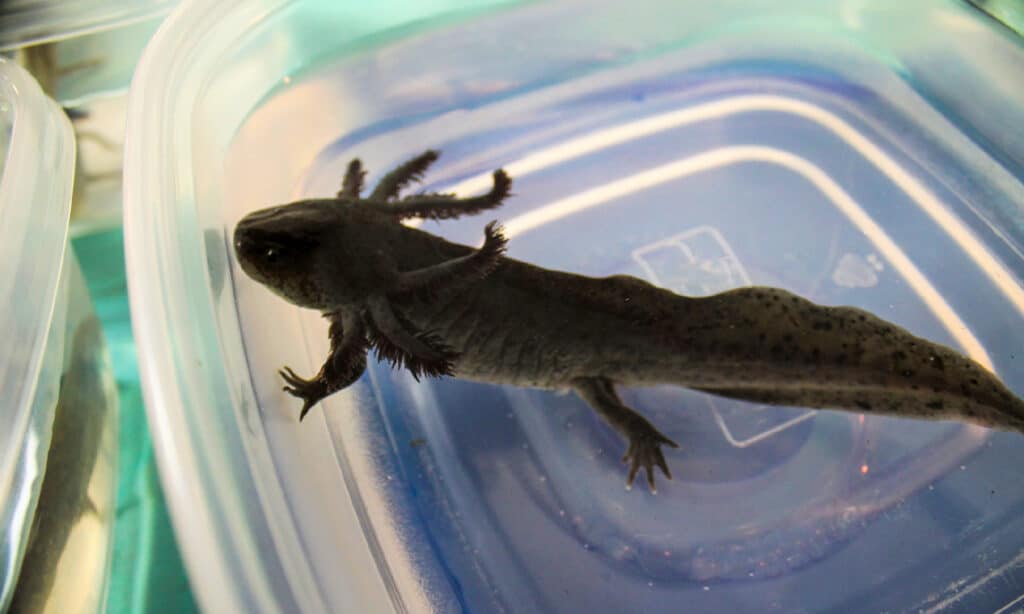
The axolotl can regrow its entire limbs.
©iStock.com/LAByrne
7. Sea Urchin
Although they may not look like it, sea urchins are interesting animals. They’re known as echinoderms, which is the same as starfish. There are several different types of sea urchins, including the “sand dollars” that you may occasionally find on the beach!
Skin breathing is a common trait in echinoderms. Their bodies are often designed in a way to increase surface area, such as through dozens of tiny tube-like feet and grooves. This helps increase the amount of oxygen they can draw in from their environment, as well as providing several other advantages to help them thrive.

Sea urchins use tube-like feet for breathing.
©NatalieJean/Shutterstock.com
8. Starfish
As mentioned above, starfish, also known as sea stars, are a common example of animals that breathe through their skin. There are around 1,900 species of starfish in the world, each one being a type of echinoderm that relies on its skin for oxygen.
Starfish don’t have lungs or true gills. They’re able to use small features on their body, known as skin gills or papulae, and their tube feet in order to draw oxygen through their skin and expel carbon dioxide. Because they rely entirely on skin breathing for survival, certain conditions or bacteria that affect the oxygen levels of water can be dangerous.
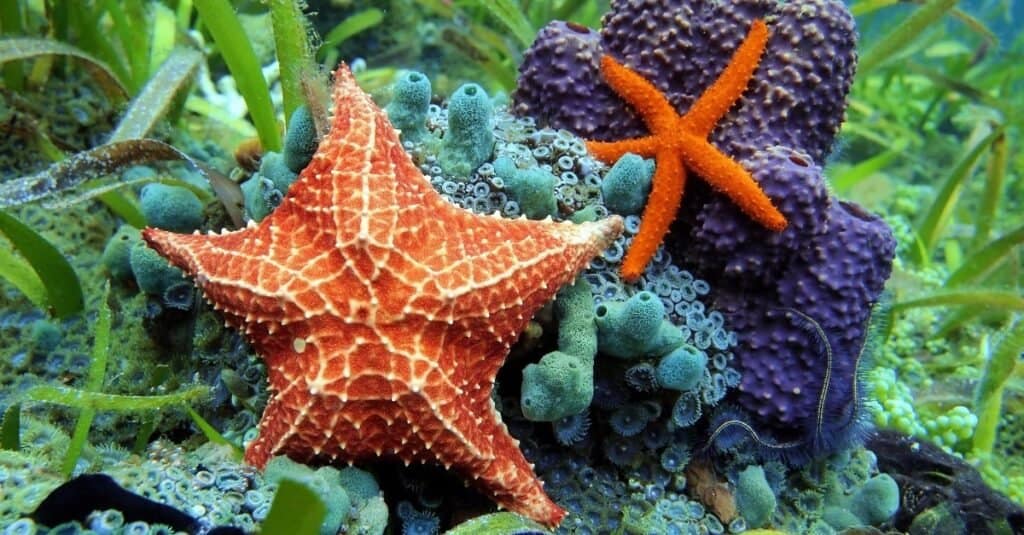
Starfish don’t have lungs or true gills.
©iStock.com/Damocean
9. Leeches
You may know leeches as parasitic worms that will latch onto humans and animals alike if you enter a lake with them. However, did you know that they are also one example of rare animals that breathe only through their skin?
Like many other types of skin-breathing animals on this list, the leech lacks both gills and lungs, making skin breathing their number one form of respiration.
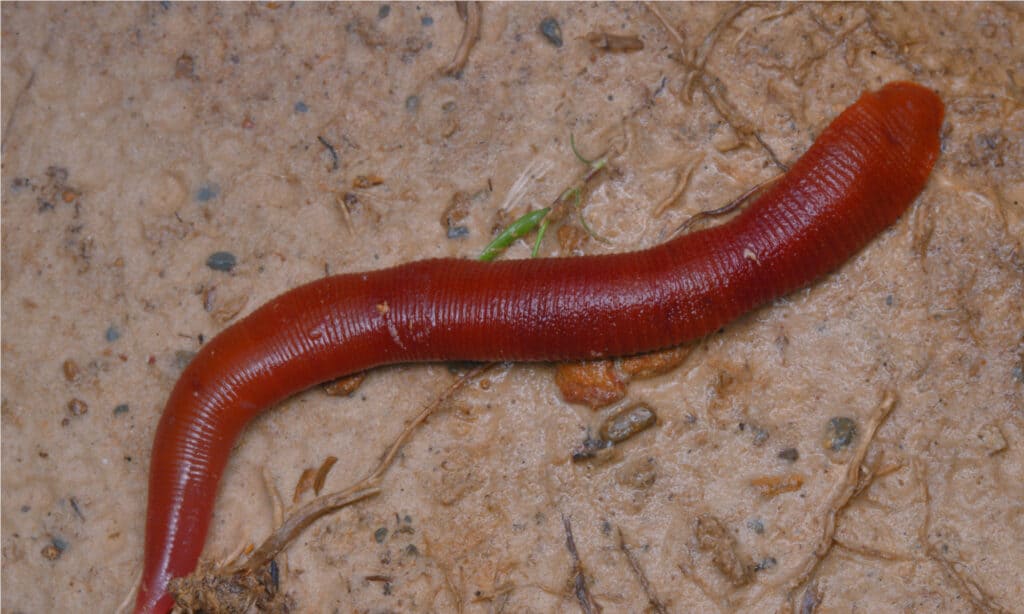
Leeches breathe through their skin.
©SIMON SHIM/Shutterstock.com
The photo featured at the top of this post is © Dave Denby Photography/Shutterstock.com
Thank you for reading! Have some feedback for us? Contact the AZ Animals editorial team.






